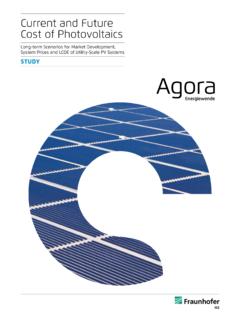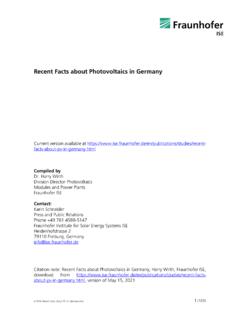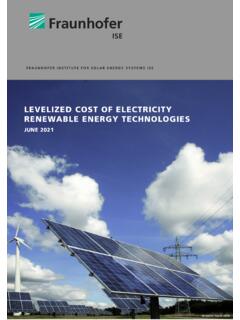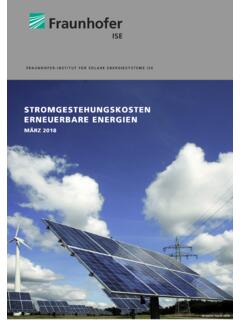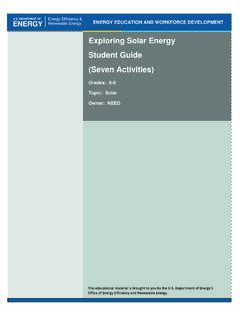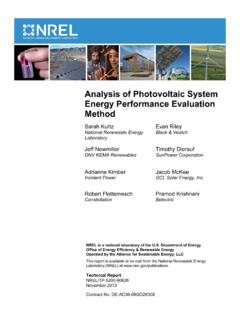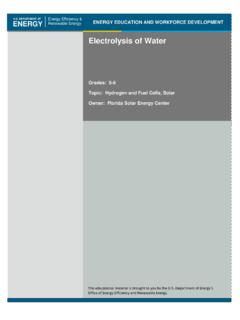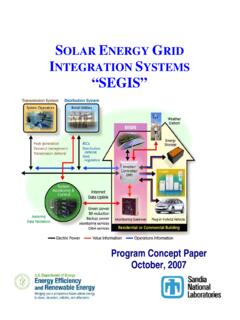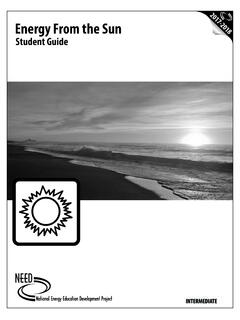Transcription of Photovoltaics Report - Fraunhofer
1 Fraunhofer ISE/Foto: Guido Kirsch Fraunhofer ISEFHG-SK: ISE-PUBLICPHOTOVOLTAICS REPORTP repared by Fraunhofer Institute for Solar energy Systems, ISEwith support of PSE Projects GmbHFreiburg, 24 February Fraunhofer ISE2 FHG-SK: ISE-PUBLICCONTENT Quick Facts Topics: PV Market Solar Cells / Modules / System Efficiency energy Return of Invest (EROI) & energy Payback Time (EPBT) Inverters Price Development Abbreviations Further Studies and Analyses Acknowledgements Fraunhofer ISE3 FHG-SK: ISE-PUBLICI ntroductionPreliminary Remarks The intention of this presentation is to provide up-to-date information. However, facts and figures change rapidly, and the given information may soon be outdated again.
2 This work has been carried out under the responsibility of Dr. Simon Philipps ( Fraunhofer ISE) and Werner Warmuth(PSE Projects GmbH). Price indications are always to be understood as nominal, unless this is stated explicitly. For example, prices in the learning curves are inflation adjusted. The slides have been made as accurate as possible and we would be grateful to receive any comments or suggestions for improvement. Please send your feedback to and also to Please quote the information presented in these slides as follows: Fraunhofer ISE: Photovoltaics Report , updated: 24 February 2022 Fraunhofer ISE4 FHG-SK: ISE-PUBLICQ uick FactsParameterValueStatusReferenceDate ofdataGermany / EU27 / WorldwidePV / 144 / 26 / 183 GWEnd of2020 End of2021*BNA / SPE / BNEFBNA / SPE / BNEF11/2021; 12/2020; 02/202202/2022; 02/2022; 02/2022 Cumulative / / 710 GWEnd of 2020 ISE / SPE / IRENA11/2021; 07/2021; 09/2021PV / BP / BP10/2021; 07/2021; 07/2021PV / BP / BP12/2021; 07/2021.
3 07/2021 Worldwidec-Si share of production 95%2020 IHS Markit05/2021 Recordsolar cell efficiency: III-V MJ (conc.) / mono-Si / CIGS / multi-Si / / / / / et PV rooftop system1,050 to 1,850 /kWpEnd of 2021 BSW11/2021 LCOE PVpower to ct / kWh2021 ISEL owest/Latest PV-Tender / kWh02/2018; 11/2021 BNA11/2021*preliminaryestimates Fraunhofer ISE5 FHG-SK: ISE-PUBLICE xecutive SummaryPV Market: Global Photovoltaics is a fast-growing market: The Compound Annual Growth Rate (CAGR) of cumulative PV installations including off-grid was 34% between year 2010 to 2020. In 2020 producers from Asia count for 95% of total c-Si PV module production. China (mainland) holds the lead with a share of 67%.
4 Europe contributed with a share of 3%; USA/CAN with 2%. Wafer size increased and by keeping the number of cells larger PV module sizes are realized allowing a power range beyond 600 W per module. In 2020, Europe s contribution to the total cumulative PV installations amounted to 22% (compared to 24% in 2019). In contrast, installations in China accounted for 33% (same value as the year before). Si-wafer based PV technology accounted for about 95% of the total production in 2020. The share of mono-crystalline technology is now about 84% (compared to 66% in 2019) of total c-Si production. Market shifts from subsidy driven to competitive pricing model (Power Purchase Agreements PPA). Fraunhofer ISE6 FHG-SK: ISE-PUBLICE xecutive SummaryPV Market: Focus Germany In year 2020, Germany accounted for about ( ) of the cumulative PV capacity installed worldwide ( GWp) with about 2 million PV systems installed in Germany.
5 In 2021 the newly installed capacity in Germany was GWp; in 2020 it was GWp. PV covered of Germany s net electricity generation in 2021 while all Renewable sources delivered about In 2020 about 35 Mio. t CO2equivalent GHG emissions have been avoided due to TWhelectrical energy generated by PV in Germany. PV system performance has strongly improved. Before 2000 the typical Performance Ratio was about 70%, while today it is in the range of 80% to 90%. Fraunhofer ISE7 FHG-SK: ISE-PUBLICE xecutive SummarySolar Cell / Module Efficiencies The record lab cell efficiency is for mono-crystalline and for multi-crystalline silicon wafer-based technology. The highest lab efficiency in thin film technology is for CIGS and for CdTesolar cells.
6 Record lab cell efficiency for Perovskite is In the last 10 years, the efficiency of average commercial wafer-based silicon modules increased from about 15% to 20% and more. At the same time, CdTemodule efficiency increased from 9% to 19%. In the laboratory, best performing modules are based on mono-crystalline silicon with efficiency. Record efficiencies demonstrate the potential for further efficiency increases at the production level. In the laboratory, high concentration multi-junction solar cells achieve an efficiency of up to today. With concentrator technology, module efficiencies of up to have been reached. Fraunhofer ISE8 FHG-SK: ISE-PUBLICE xecutive SummaryEnergy Payback Time Material usage for silicon cells has been reduced significantly during the last 16 years from around 16 g/Wp to about 3 g/Wp due to increased efficiencies, thinner wafers and diamond wire sawing as well as larger ingots.
7 The energy Payback Time of PV systems is dependent on the geographical location: PV systems in Northern Europe need around years to balance the input energy , while PV systems in the South equal their energy input after 1 year and less, depending on the technology installed and the grid efficiency. A PV system located in Sicily with wafer-based Silicon modules has an energy Payback Time of around one year. Assuming 20 years lifespan, this kind of system can produce twenty times the energy needed to produce it. Fraunhofer ISE9 FHG-SK: ISE-PUBLICE xecutive SummaryInverters Inverter efficiency for state-of-the art brand products is 98% and higher. The market share of string inverters is estimated to be 64%.
8 These inverters are mostly used in residential, small and medium commercial applications in PV systems up to 150 kWp. The market share of central inverters, with applications mostly in large commercial and utility-scale systems, is about 34%. A small proportion of the market (about 1%) belongs to micro-inverters (used on the module level). The market share for DC / DC converters, also called power optimizers , is estimated to be 5% of the total inverter market. Trends: Digitalisation, Repowering, new features for grid stabilization and optimization of self-consumption; storage; utilization of innovative semiconductors (SiCor GaN) which allow very high efficiencies and compact designs; 1500 V maximum DC string voltage.
9 Fraunhofer ISE10 FHG-SK: ISE-PUBLICE xecutive SummaryPrice Development In Germany prices for a typical 10 to 100 kWpPV rooftop-system were around 14,000 /kWpin 1990. At the end of 2020, such systems cost only of the price in 1990. This is a net-price regression of about 92% over a period of 30 years. The Experience Curve also called Learning Curve - shows that in the last 40 years the module price decreased by 26% with each doubling of the cumulated global module production. Cost reduction results from economies of scale and technological improvements. Fraunhofer ISE11 FHG-SK: ISE-PUBLIC1. PV Market By region By technology Fraunhofer ISE12 FHG-SK: ISE-PUBLICPV Module Production by Region 1990-2020 Percentage of Total MWp ProducedData: Up to2004 StrategiesUnlimited; 2005 to2009: Navigant Consulting; since 2010: IHS Markit.
10 Graph: PSE 2021 Fraunhofer ISE Fraunhofer ISE13 FHG-SK: ISE-PUBLICPV Module Production by RegionGlobal Annual ProductionData: IHS Markit 2021. Graph: PSE 2021; Date ofdata: 19-May 2021 Fraunhofer ISEA bout82% (mainland)accountedwithabout97 GWfor67% factorof7 inthisdecade. Fraunhofer ISE14 FHG-SK: ISE-PUBLICC urrentEuropean c-Si PV Manufacturing Landscape Status Quo, End of2020> 50 MWp> 100 MWp> 500 MWpCellModuleIngot / PWNorSunmg-Si Poly-SiELKEMN orwegianCrystalsSolaicopccSESunergSolarR ECOMS illiaValue chainstepFactory sizeHanplastAltiusKnessgroupMegasolSunPo werWackerSoluxtecPeimarBiSolEclipseJAHAK iotoSolvisBruk-BetSelfaXdiscsPikCellSili conProductsStakksberg> 1 GWpTotal capacities within theEU [GWp/a] Solar and Graph: Jochen Rentsch, Fraunhofer ISE 2021 Fraunhofer ISE Fraunhofer ISE15 FHG-SK: ISE-PUBLICG lobal Cumulative PV InstallationFrom 2010 to 2020 Data: IRENA 2021.
